Critical Analysis of Leadership Capacity in Early Childhood Settings
VerifiedAdded on 2023/01/13
|11
|2765
|34
Essay
AI Summary
This essay provides a critical analysis of leadership capacity within the context of early childhood education, focusing on administration and governance. It explores key aspects such as culture and climate, effective communication, and privacy and confidentiality. The essay delves into the importance of quality educational practices and the role of leadership in fostering a conducive working environment, including the significance of training and professional development for educators. It examines the role of Administration and Governance, highlighting the importance of ethical practices, accountability, and effective communication. The essay further discusses relevant leadership theories and models, including Hayden's Model and Situational Leadership Theory, and their application in early childhood settings. It also explores the Dimensions of Organisational Climate model and its impact on creating an effective environment. The essay concludes with strategies to enhance leadership within early education, such as effective training programs, implementation of situational leadership styles, and development of career development plans. This work is a contribution to Desklib, a platform offering AI-driven study tools.
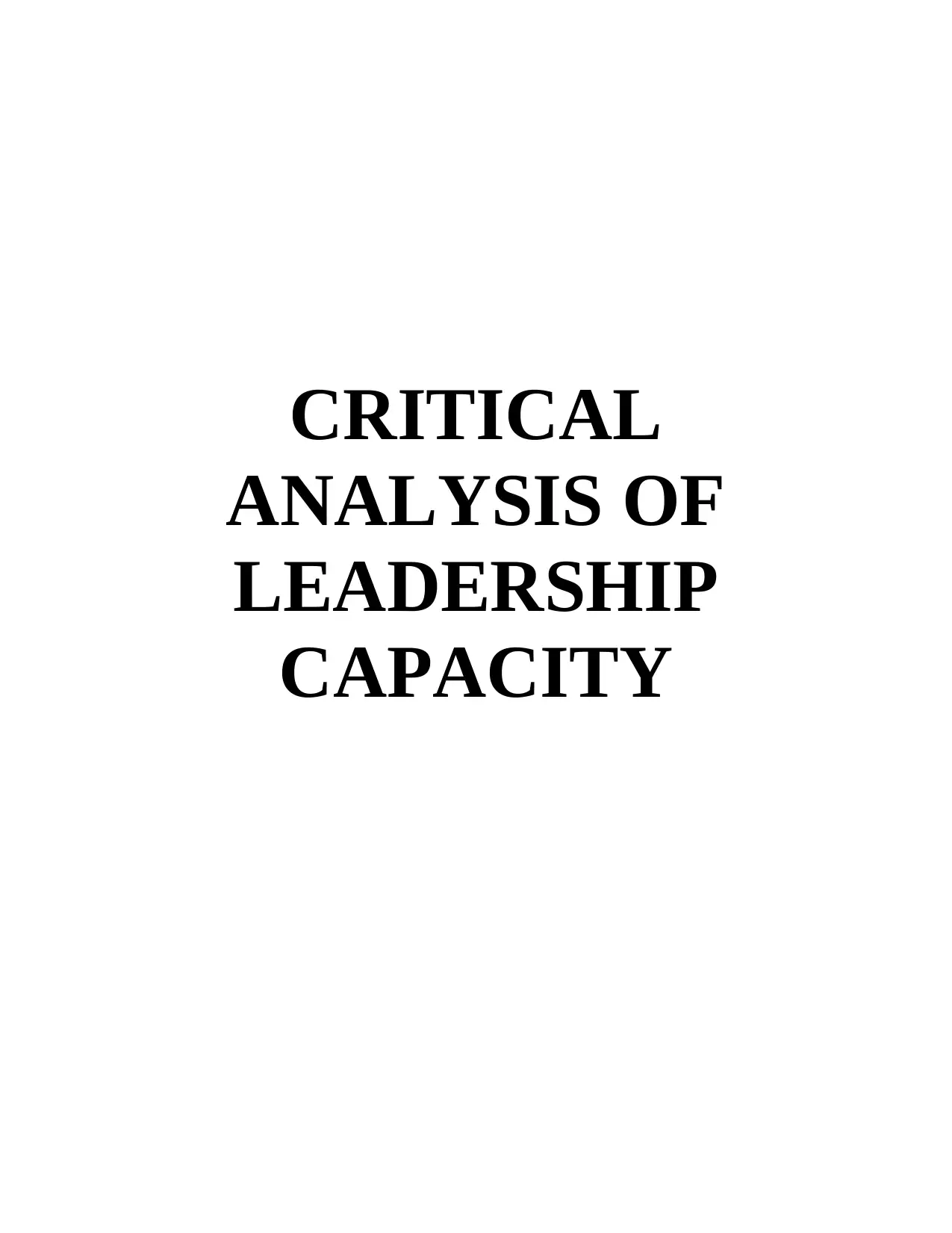
CRITICAL
ANALYSIS OF
LEADERSHIP
CAPACITY
ANALYSIS OF
LEADERSHIP
CAPACITY
Paraphrase This Document
Need a fresh take? Get an instant paraphrase of this document with our AI Paraphraser
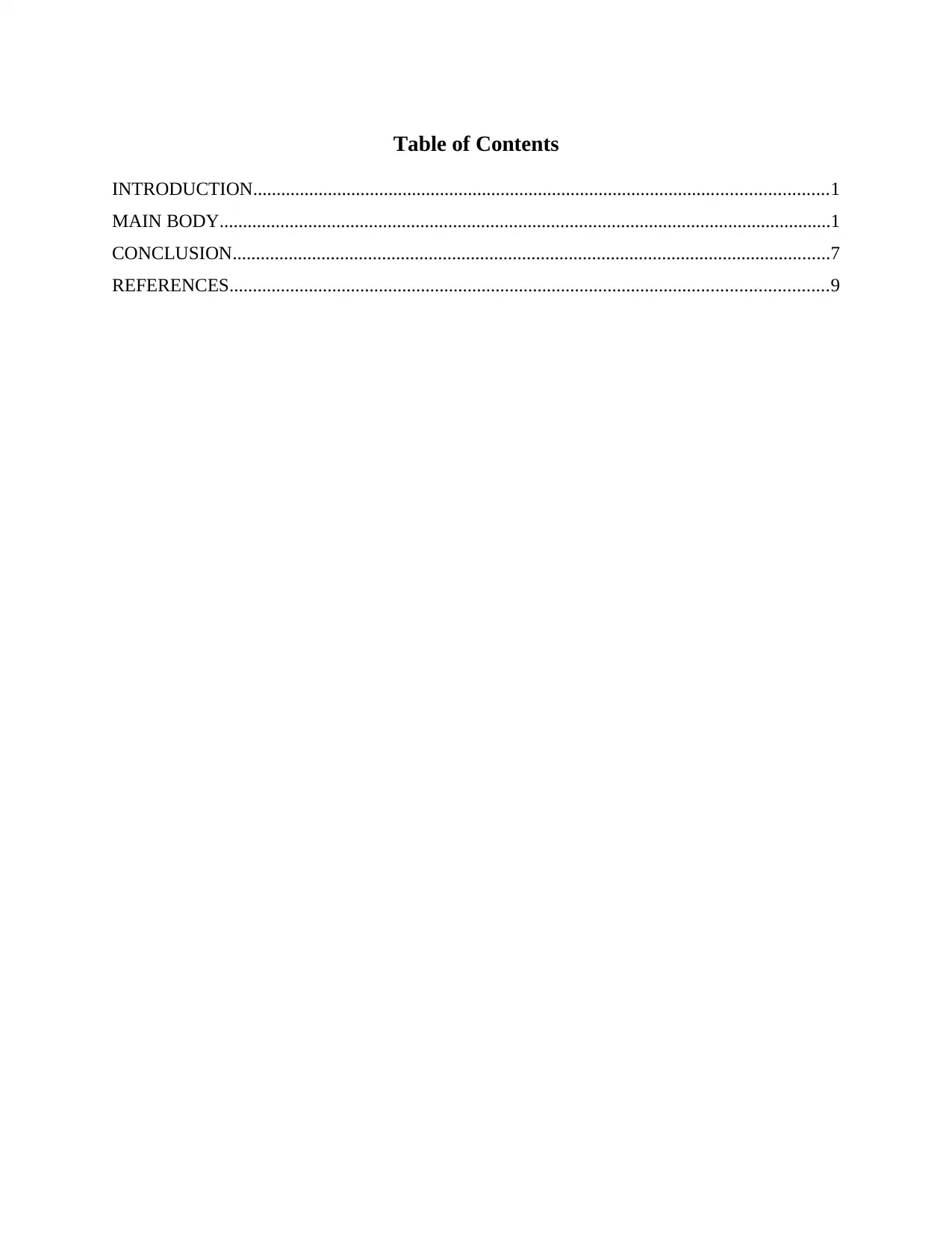
Table of Contents
INTRODUCTION...........................................................................................................................1
MAIN BODY...................................................................................................................................1
CONCLUSION................................................................................................................................7
REFERENCES................................................................................................................................9
INTRODUCTION...........................................................................................................................1
MAIN BODY...................................................................................................................................1
CONCLUSION................................................................................................................................7
REFERENCES................................................................................................................................9
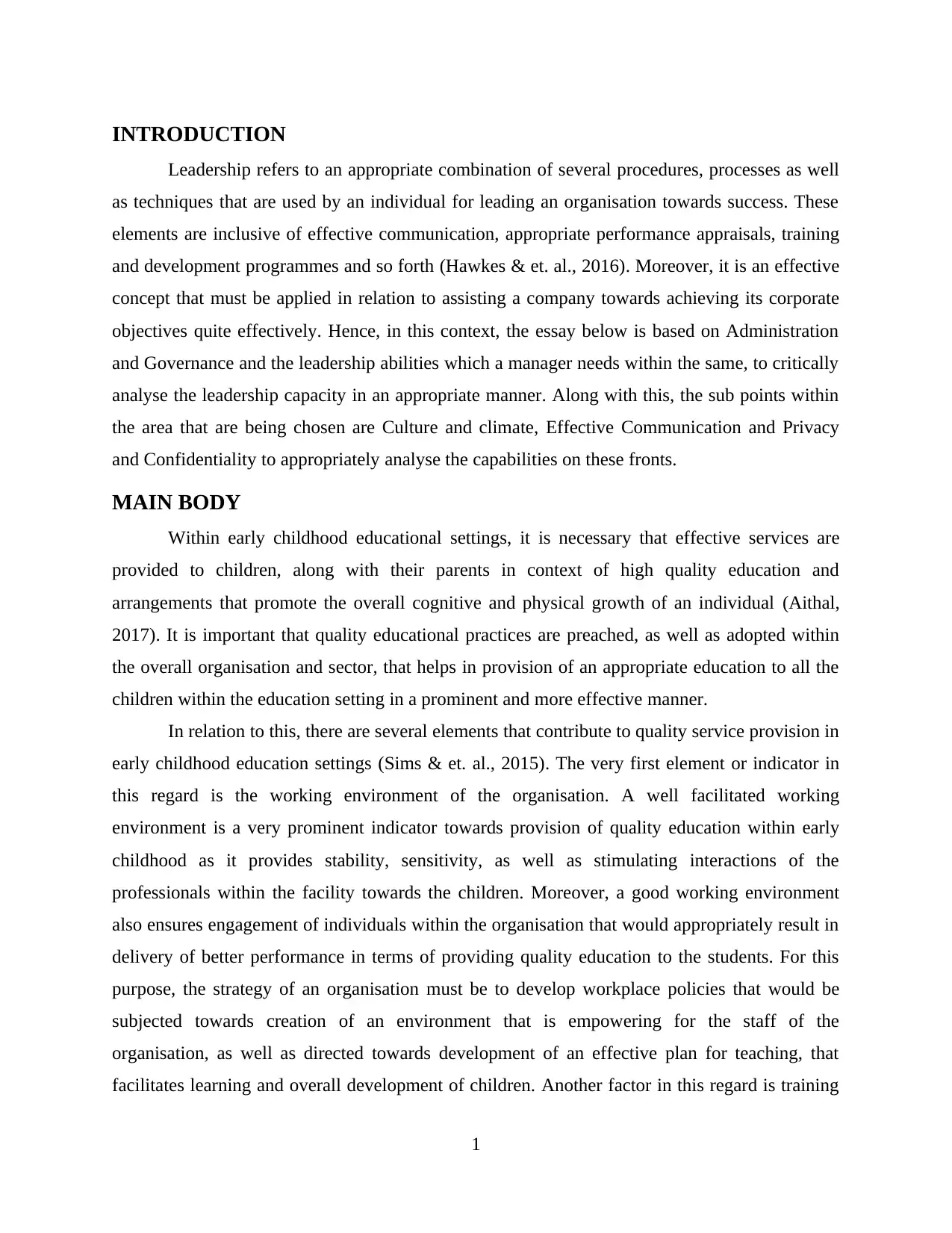
INTRODUCTION
Leadership refers to an appropriate combination of several procedures, processes as well
as techniques that are used by an individual for leading an organisation towards success. These
elements are inclusive of effective communication, appropriate performance appraisals, training
and development programmes and so forth (Hawkes & et. al., 2016). Moreover, it is an effective
concept that must be applied in relation to assisting a company towards achieving its corporate
objectives quite effectively. Hence, in this context, the essay below is based on Administration
and Governance and the leadership abilities which a manager needs within the same, to critically
analyse the leadership capacity in an appropriate manner. Along with this, the sub points within
the area that are being chosen are Culture and climate, Effective Communication and Privacy
and Confidentiality to appropriately analyse the capabilities on these fronts.
MAIN BODY
Within early childhood educational settings, it is necessary that effective services are
provided to children, along with their parents in context of high quality education and
arrangements that promote the overall cognitive and physical growth of an individual (Aithal,
2017). It is important that quality educational practices are preached, as well as adopted within
the overall organisation and sector, that helps in provision of an appropriate education to all the
children within the education setting in a prominent and more effective manner.
In relation to this, there are several elements that contribute to quality service provision in
early childhood education settings (Sims & et. al., 2015). The very first element or indicator in
this regard is the working environment of the organisation. A well facilitated working
environment is a very prominent indicator towards provision of quality education within early
childhood as it provides stability, sensitivity, as well as stimulating interactions of the
professionals within the facility towards the children. Moreover, a good working environment
also ensures engagement of individuals within the organisation that would appropriately result in
delivery of better performance in terms of providing quality education to the students. For this
purpose, the strategy of an organisation must be to develop workplace policies that would be
subjected towards creation of an environment that is empowering for the staff of the
organisation, as well as directed towards development of an effective plan for teaching, that
facilitates learning and overall development of children. Another factor in this regard is training
1
Leadership refers to an appropriate combination of several procedures, processes as well
as techniques that are used by an individual for leading an organisation towards success. These
elements are inclusive of effective communication, appropriate performance appraisals, training
and development programmes and so forth (Hawkes & et. al., 2016). Moreover, it is an effective
concept that must be applied in relation to assisting a company towards achieving its corporate
objectives quite effectively. Hence, in this context, the essay below is based on Administration
and Governance and the leadership abilities which a manager needs within the same, to critically
analyse the leadership capacity in an appropriate manner. Along with this, the sub points within
the area that are being chosen are Culture and climate, Effective Communication and Privacy
and Confidentiality to appropriately analyse the capabilities on these fronts.
MAIN BODY
Within early childhood educational settings, it is necessary that effective services are
provided to children, along with their parents in context of high quality education and
arrangements that promote the overall cognitive and physical growth of an individual (Aithal,
2017). It is important that quality educational practices are preached, as well as adopted within
the overall organisation and sector, that helps in provision of an appropriate education to all the
children within the education setting in a prominent and more effective manner.
In relation to this, there are several elements that contribute to quality service provision in
early childhood education settings (Sims & et. al., 2015). The very first element or indicator in
this regard is the working environment of the organisation. A well facilitated working
environment is a very prominent indicator towards provision of quality education within early
childhood as it provides stability, sensitivity, as well as stimulating interactions of the
professionals within the facility towards the children. Moreover, a good working environment
also ensures engagement of individuals within the organisation that would appropriately result in
delivery of better performance in terms of providing quality education to the students. For this
purpose, the strategy of an organisation must be to develop workplace policies that would be
subjected towards creation of an environment that is empowering for the staff of the
organisation, as well as directed towards development of an effective plan for teaching, that
facilitates learning and overall development of children. Another factor in this regard is training
1
⊘ This is a preview!⊘
Do you want full access?
Subscribe today to unlock all pages.

Trusted by 1+ million students worldwide
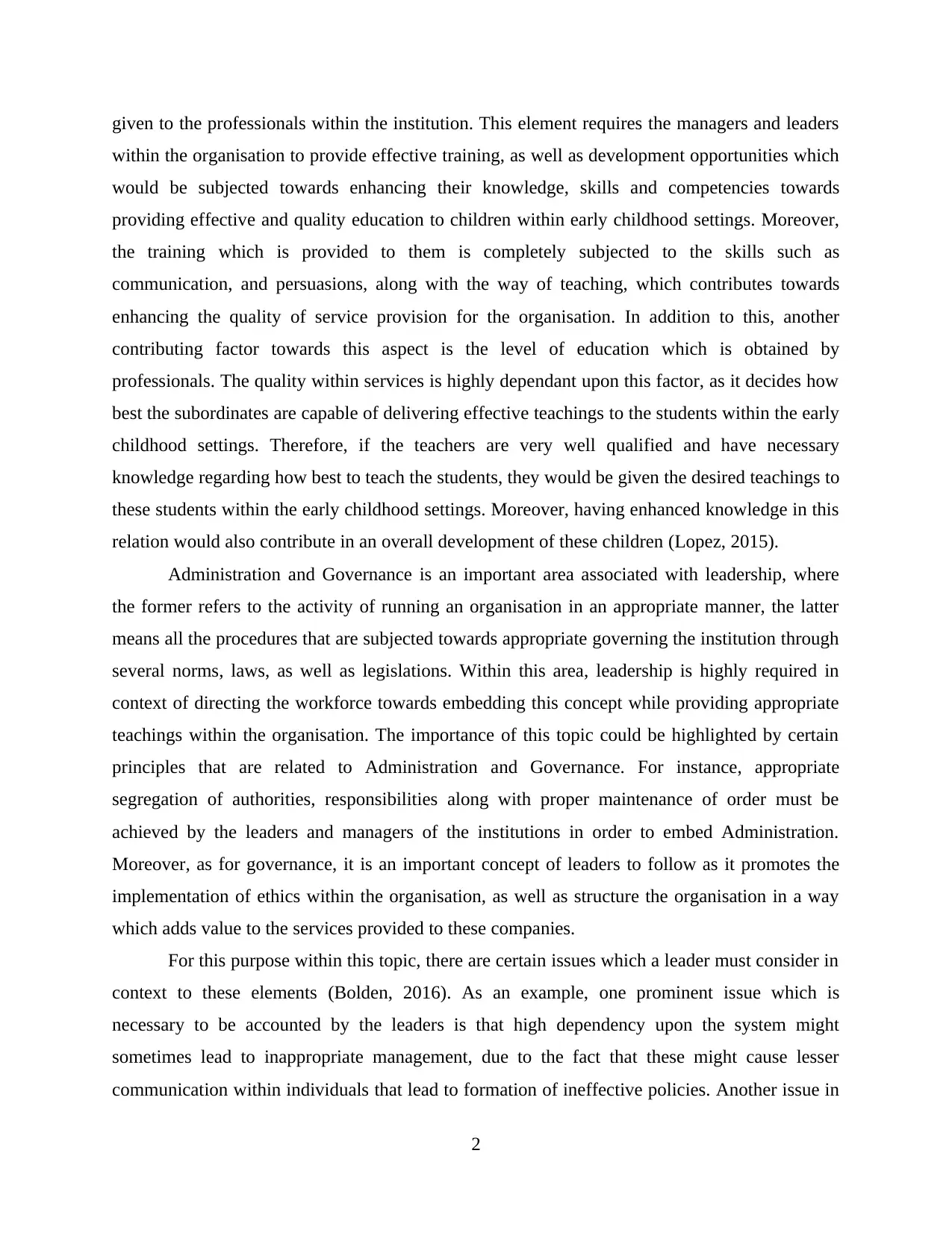
given to the professionals within the institution. This element requires the managers and leaders
within the organisation to provide effective training, as well as development opportunities which
would be subjected towards enhancing their knowledge, skills and competencies towards
providing effective and quality education to children within early childhood settings. Moreover,
the training which is provided to them is completely subjected to the skills such as
communication, and persuasions, along with the way of teaching, which contributes towards
enhancing the quality of service provision for the organisation. In addition to this, another
contributing factor towards this aspect is the level of education which is obtained by
professionals. The quality within services is highly dependant upon this factor, as it decides how
best the subordinates are capable of delivering effective teachings to the students within the early
childhood settings. Therefore, if the teachers are very well qualified and have necessary
knowledge regarding how best to teach the students, they would be given the desired teachings to
these students within the early childhood settings. Moreover, having enhanced knowledge in this
relation would also contribute in an overall development of these children (Lopez, 2015).
Administration and Governance is an important area associated with leadership, where
the former refers to the activity of running an organisation in an appropriate manner, the latter
means all the procedures that are subjected towards appropriate governing the institution through
several norms, laws, as well as legislations. Within this area, leadership is highly required in
context of directing the workforce towards embedding this concept while providing appropriate
teachings within the organisation. The importance of this topic could be highlighted by certain
principles that are related to Administration and Governance. For instance, appropriate
segregation of authorities, responsibilities along with proper maintenance of order must be
achieved by the leaders and managers of the institutions in order to embed Administration.
Moreover, as for governance, it is an important concept of leaders to follow as it promotes the
implementation of ethics within the organisation, as well as structure the organisation in a way
which adds value to the services provided to these companies.
For this purpose within this topic, there are certain issues which a leader must consider in
context to these elements (Bolden, 2016). As an example, one prominent issue which is
necessary to be accounted by the leaders is that high dependency upon the system might
sometimes lead to inappropriate management, due to the fact that these might cause lesser
communication within individuals that lead to formation of ineffective policies. Another issue in
2
within the organisation to provide effective training, as well as development opportunities which
would be subjected towards enhancing their knowledge, skills and competencies towards
providing effective and quality education to children within early childhood settings. Moreover,
the training which is provided to them is completely subjected to the skills such as
communication, and persuasions, along with the way of teaching, which contributes towards
enhancing the quality of service provision for the organisation. In addition to this, another
contributing factor towards this aspect is the level of education which is obtained by
professionals. The quality within services is highly dependant upon this factor, as it decides how
best the subordinates are capable of delivering effective teachings to the students within the early
childhood settings. Therefore, if the teachers are very well qualified and have necessary
knowledge regarding how best to teach the students, they would be given the desired teachings to
these students within the early childhood settings. Moreover, having enhanced knowledge in this
relation would also contribute in an overall development of these children (Lopez, 2015).
Administration and Governance is an important area associated with leadership, where
the former refers to the activity of running an organisation in an appropriate manner, the latter
means all the procedures that are subjected towards appropriate governing the institution through
several norms, laws, as well as legislations. Within this area, leadership is highly required in
context of directing the workforce towards embedding this concept while providing appropriate
teachings within the organisation. The importance of this topic could be highlighted by certain
principles that are related to Administration and Governance. For instance, appropriate
segregation of authorities, responsibilities along with proper maintenance of order must be
achieved by the leaders and managers of the institutions in order to embed Administration.
Moreover, as for governance, it is an important concept of leaders to follow as it promotes the
implementation of ethics within the organisation, as well as structure the organisation in a way
which adds value to the services provided to these companies.
For this purpose within this topic, there are certain issues which a leader must consider in
context to these elements (Bolden, 2016). As an example, one prominent issue which is
necessary to be accounted by the leaders is that high dependency upon the system might
sometimes lead to inappropriate management, due to the fact that these might cause lesser
communication within individuals that lead to formation of ineffective policies. Another issue in
2
Paraphrase This Document
Need a fresh take? Get an instant paraphrase of this document with our AI Paraphraser
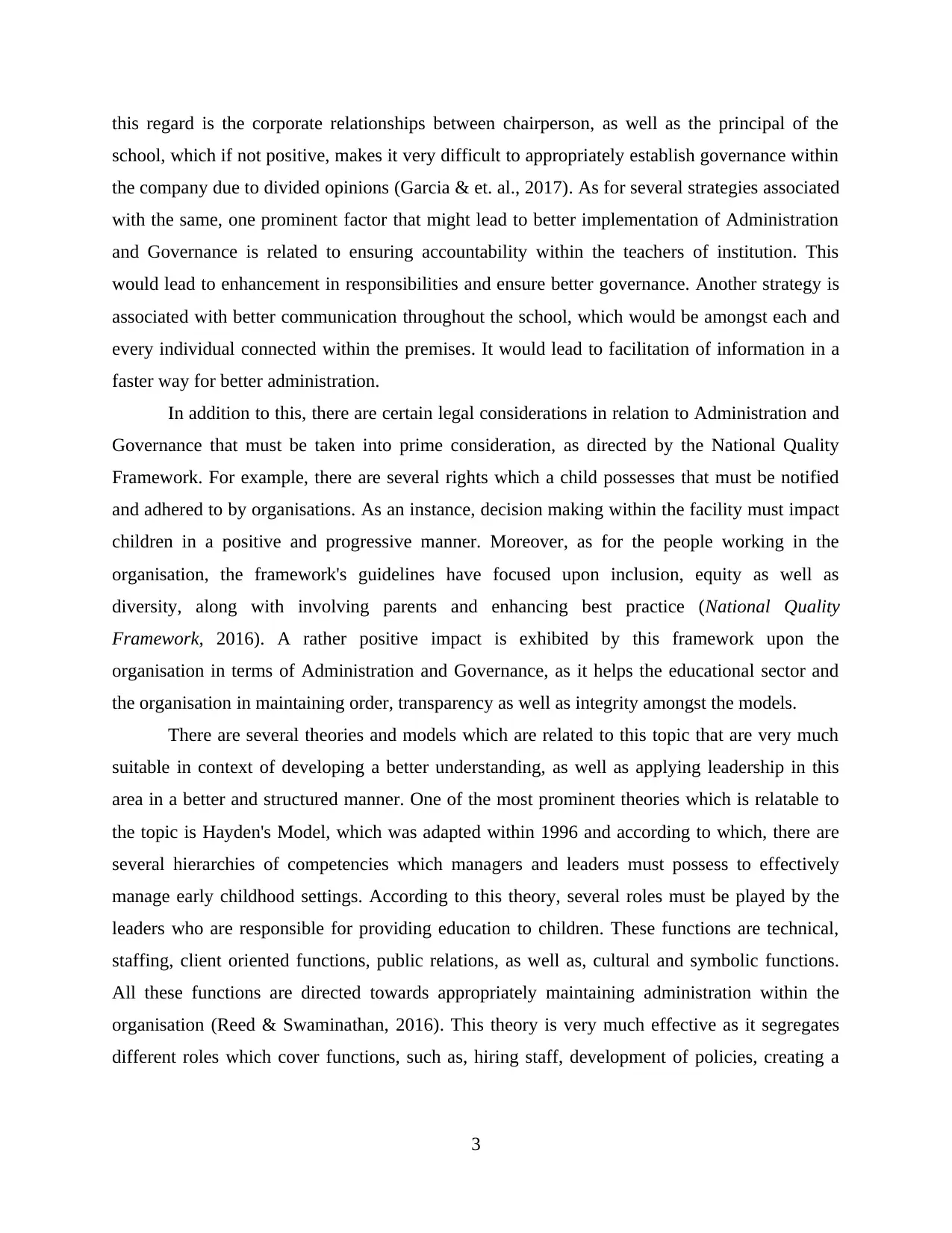
this regard is the corporate relationships between chairperson, as well as the principal of the
school, which if not positive, makes it very difficult to appropriately establish governance within
the company due to divided opinions (Garcia & et. al., 2017). As for several strategies associated
with the same, one prominent factor that might lead to better implementation of Administration
and Governance is related to ensuring accountability within the teachers of institution. This
would lead to enhancement in responsibilities and ensure better governance. Another strategy is
associated with better communication throughout the school, which would be amongst each and
every individual connected within the premises. It would lead to facilitation of information in a
faster way for better administration.
In addition to this, there are certain legal considerations in relation to Administration and
Governance that must be taken into prime consideration, as directed by the National Quality
Framework. For example, there are several rights which a child possesses that must be notified
and adhered to by organisations. As an instance, decision making within the facility must impact
children in a positive and progressive manner. Moreover, as for the people working in the
organisation, the framework's guidelines have focused upon inclusion, equity as well as
diversity, along with involving parents and enhancing best practice (National Quality
Framework, 2016). A rather positive impact is exhibited by this framework upon the
organisation in terms of Administration and Governance, as it helps the educational sector and
the organisation in maintaining order, transparency as well as integrity amongst the models.
There are several theories and models which are related to this topic that are very much
suitable in context of developing a better understanding, as well as applying leadership in this
area in a better and structured manner. One of the most prominent theories which is relatable to
the topic is Hayden's Model, which was adapted within 1996 and according to which, there are
several hierarchies of competencies which managers and leaders must possess to effectively
manage early childhood settings. According to this theory, several roles must be played by the
leaders who are responsible for providing education to children. These functions are technical,
staffing, client oriented functions, public relations, as well as, cultural and symbolic functions.
All these functions are directed towards appropriately maintaining administration within the
organisation (Reed & Swaminathan, 2016). This theory is very much effective as it segregates
different roles which cover functions, such as, hiring staff, development of policies, creating a
3
school, which if not positive, makes it very difficult to appropriately establish governance within
the company due to divided opinions (Garcia & et. al., 2017). As for several strategies associated
with the same, one prominent factor that might lead to better implementation of Administration
and Governance is related to ensuring accountability within the teachers of institution. This
would lead to enhancement in responsibilities and ensure better governance. Another strategy is
associated with better communication throughout the school, which would be amongst each and
every individual connected within the premises. It would lead to facilitation of information in a
faster way for better administration.
In addition to this, there are certain legal considerations in relation to Administration and
Governance that must be taken into prime consideration, as directed by the National Quality
Framework. For example, there are several rights which a child possesses that must be notified
and adhered to by organisations. As an instance, decision making within the facility must impact
children in a positive and progressive manner. Moreover, as for the people working in the
organisation, the framework's guidelines have focused upon inclusion, equity as well as
diversity, along with involving parents and enhancing best practice (National Quality
Framework, 2016). A rather positive impact is exhibited by this framework upon the
organisation in terms of Administration and Governance, as it helps the educational sector and
the organisation in maintaining order, transparency as well as integrity amongst the models.
There are several theories and models which are related to this topic that are very much
suitable in context of developing a better understanding, as well as applying leadership in this
area in a better and structured manner. One of the most prominent theories which is relatable to
the topic is Hayden's Model, which was adapted within 1996 and according to which, there are
several hierarchies of competencies which managers and leaders must possess to effectively
manage early childhood settings. According to this theory, several roles must be played by the
leaders who are responsible for providing education to children. These functions are technical,
staffing, client oriented functions, public relations, as well as, cultural and symbolic functions.
All these functions are directed towards appropriately maintaining administration within the
organisation (Reed & Swaminathan, 2016). This theory is very much effective as it segregates
different roles which cover functions, such as, hiring staff, development of policies, creating a
3
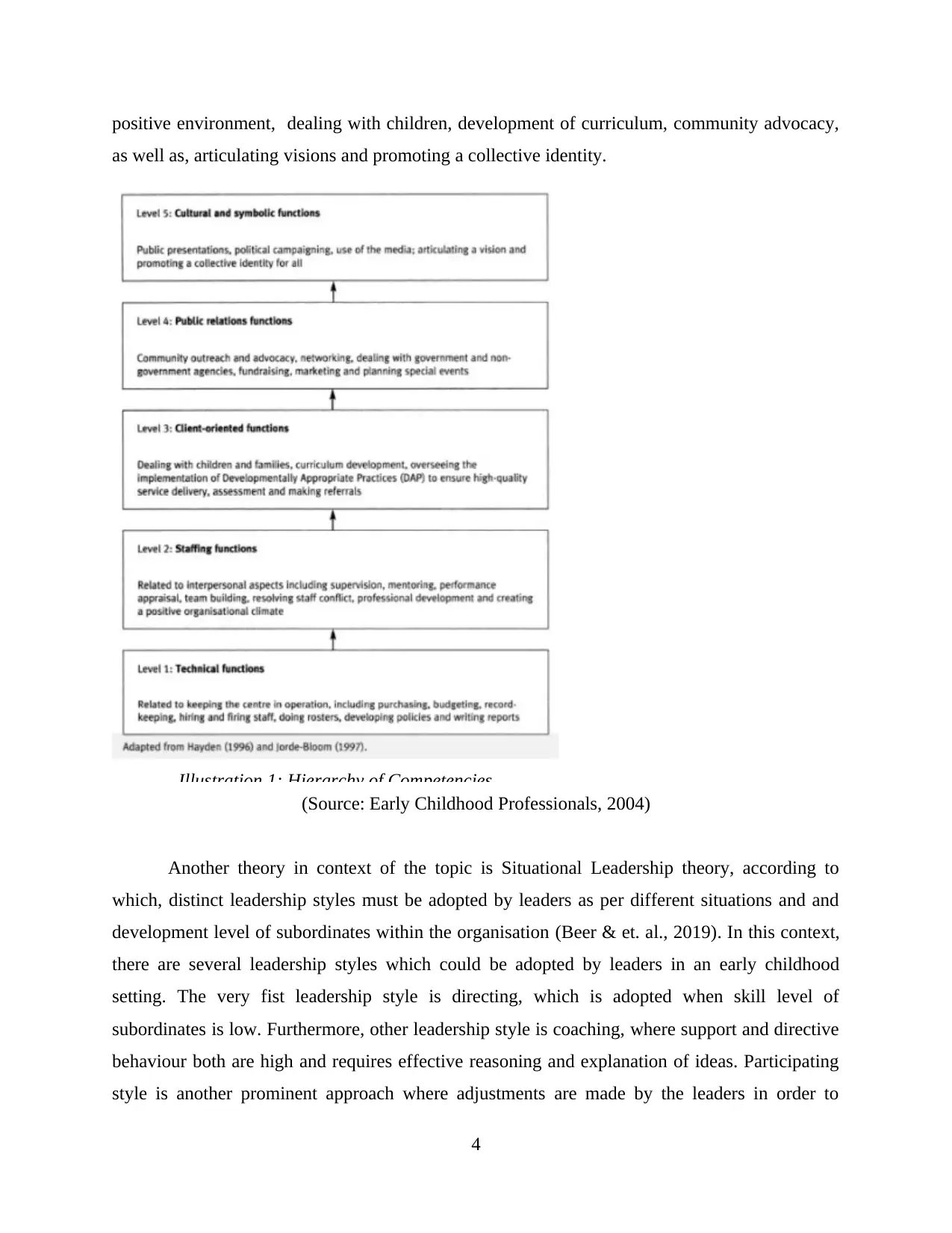
positive environment, dealing with children, development of curriculum, community advocacy,
as well as, articulating visions and promoting a collective identity.
Illustration 1: Hierarchy of Competencies
(Source: Early Childhood Professionals, 2004)
Another theory in context of the topic is Situational Leadership theory, according to
which, distinct leadership styles must be adopted by leaders as per different situations and and
development level of subordinates within the organisation (Beer & et. al., 2019). In this context,
there are several leadership styles which could be adopted by leaders in an early childhood
setting. The very fist leadership style is directing, which is adopted when skill level of
subordinates is low. Furthermore, other leadership style is coaching, where support and directive
behaviour both are high and requires effective reasoning and explanation of ideas. Participating
style is another prominent approach where adjustments are made by the leaders in order to
4
as well as, articulating visions and promoting a collective identity.
Illustration 1: Hierarchy of Competencies
(Source: Early Childhood Professionals, 2004)
Another theory in context of the topic is Situational Leadership theory, according to
which, distinct leadership styles must be adopted by leaders as per different situations and and
development level of subordinates within the organisation (Beer & et. al., 2019). In this context,
there are several leadership styles which could be adopted by leaders in an early childhood
setting. The very fist leadership style is directing, which is adopted when skill level of
subordinates is low. Furthermore, other leadership style is coaching, where support and directive
behaviour both are high and requires effective reasoning and explanation of ideas. Participating
style is another prominent approach where adjustments are made by the leaders in order to
4
⊘ This is a preview!⊘
Do you want full access?
Subscribe today to unlock all pages.

Trusted by 1+ million students worldwide
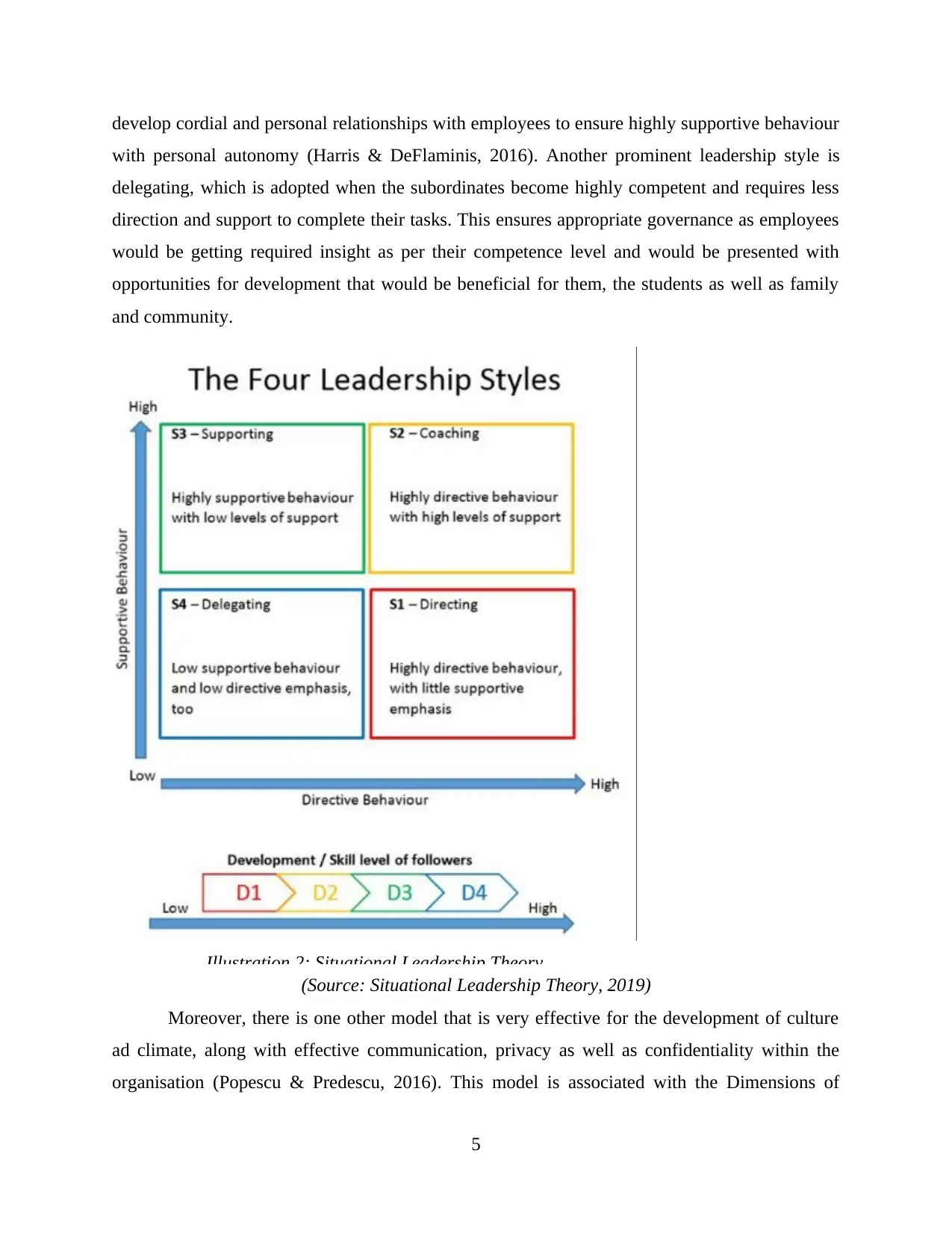
develop cordial and personal relationships with employees to ensure highly supportive behaviour
with personal autonomy (Harris & DeFlaminis, 2016). Another prominent leadership style is
delegating, which is adopted when the subordinates become highly competent and requires less
direction and support to complete their tasks. This ensures appropriate governance as employees
would be getting required insight as per their competence level and would be presented with
opportunities for development that would be beneficial for them, the students as well as family
and community.
Illustration 2: Situational Leadership Theory
(Source: Situational Leadership Theory, 2019)
Moreover, there is one other model that is very effective for the development of culture
ad climate, along with effective communication, privacy as well as confidentiality within the
organisation (Popescu & Predescu, 2016). This model is associated with the Dimensions of
5
with personal autonomy (Harris & DeFlaminis, 2016). Another prominent leadership style is
delegating, which is adopted when the subordinates become highly competent and requires less
direction and support to complete their tasks. This ensures appropriate governance as employees
would be getting required insight as per their competence level and would be presented with
opportunities for development that would be beneficial for them, the students as well as family
and community.
Illustration 2: Situational Leadership Theory
(Source: Situational Leadership Theory, 2019)
Moreover, there is one other model that is very effective for the development of culture
ad climate, along with effective communication, privacy as well as confidentiality within the
organisation (Popescu & Predescu, 2016). This model is associated with the Dimensions of
5
Paraphrase This Document
Need a fresh take? Get an instant paraphrase of this document with our AI Paraphraser
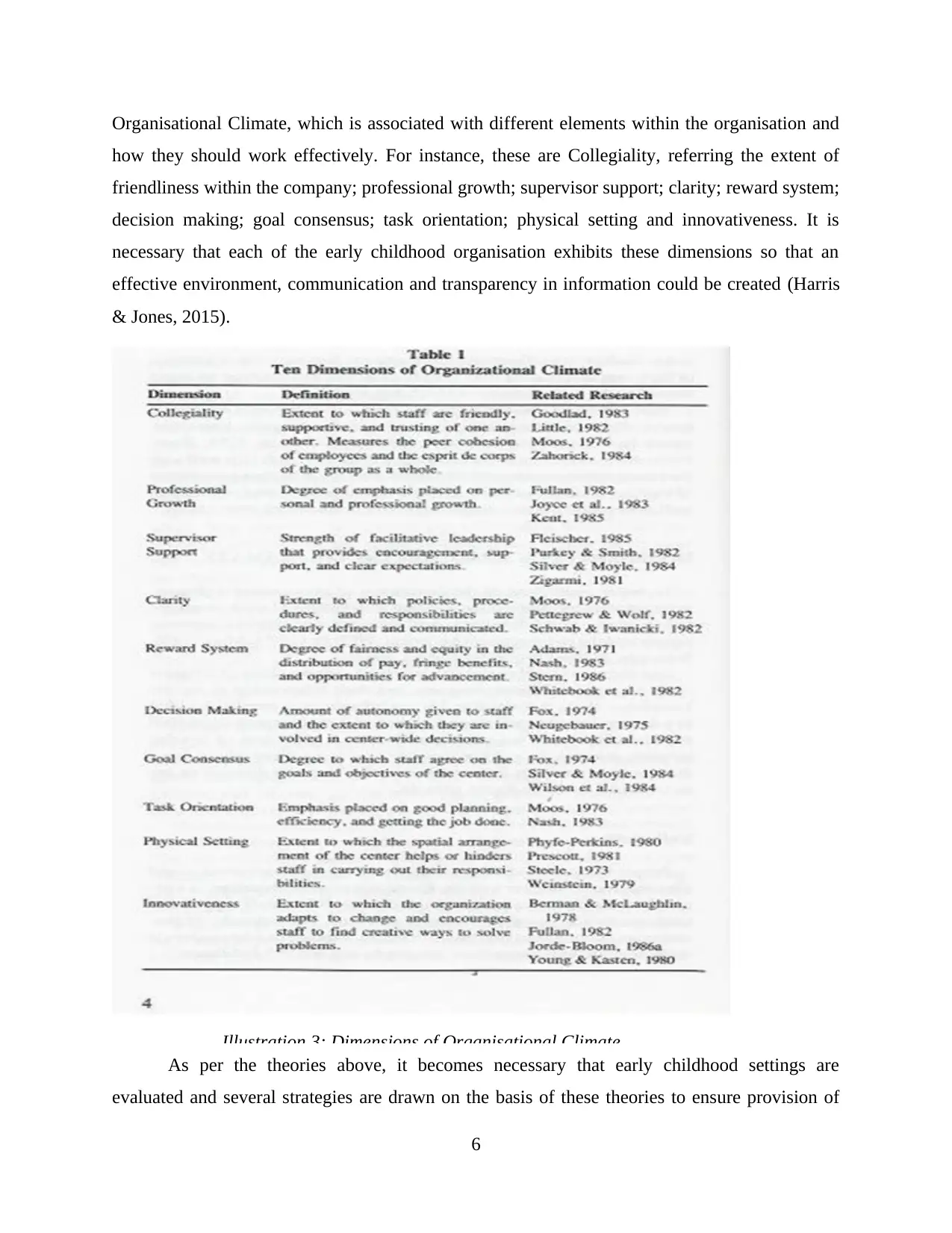
Organisational Climate, which is associated with different elements within the organisation and
how they should work effectively. For instance, these are Collegiality, referring the extent of
friendliness within the company; professional growth; supervisor support; clarity; reward system;
decision making; goal consensus; task orientation; physical setting and innovativeness. It is
necessary that each of the early childhood organisation exhibits these dimensions so that an
effective environment, communication and transparency in information could be created (Harris
& Jones, 2015).
Illustration 3: Dimensions of Organisational Climate
As per the theories above, it becomes necessary that early childhood settings are
evaluated and several strategies are drawn on the basis of these theories to ensure provision of
6
how they should work effectively. For instance, these are Collegiality, referring the extent of
friendliness within the company; professional growth; supervisor support; clarity; reward system;
decision making; goal consensus; task orientation; physical setting and innovativeness. It is
necessary that each of the early childhood organisation exhibits these dimensions so that an
effective environment, communication and transparency in information could be created (Harris
& Jones, 2015).
Illustration 3: Dimensions of Organisational Climate
As per the theories above, it becomes necessary that early childhood settings are
evaluated and several strategies are drawn on the basis of these theories to ensure provision of
6
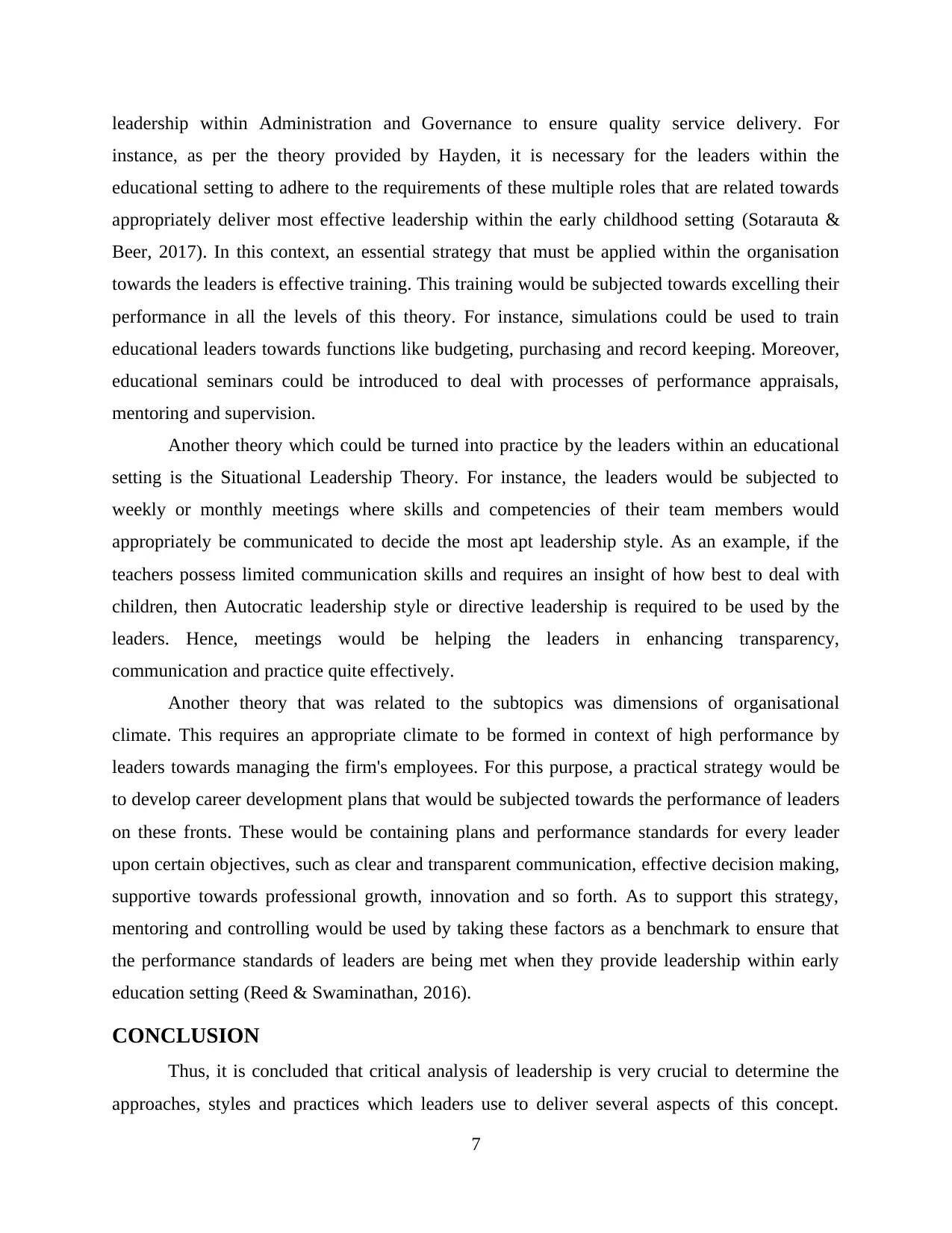
leadership within Administration and Governance to ensure quality service delivery. For
instance, as per the theory provided by Hayden, it is necessary for the leaders within the
educational setting to adhere to the requirements of these multiple roles that are related towards
appropriately deliver most effective leadership within the early childhood setting (Sotarauta &
Beer, 2017). In this context, an essential strategy that must be applied within the organisation
towards the leaders is effective training. This training would be subjected towards excelling their
performance in all the levels of this theory. For instance, simulations could be used to train
educational leaders towards functions like budgeting, purchasing and record keeping. Moreover,
educational seminars could be introduced to deal with processes of performance appraisals,
mentoring and supervision.
Another theory which could be turned into practice by the leaders within an educational
setting is the Situational Leadership Theory. For instance, the leaders would be subjected to
weekly or monthly meetings where skills and competencies of their team members would
appropriately be communicated to decide the most apt leadership style. As an example, if the
teachers possess limited communication skills and requires an insight of how best to deal with
children, then Autocratic leadership style or directive leadership is required to be used by the
leaders. Hence, meetings would be helping the leaders in enhancing transparency,
communication and practice quite effectively.
Another theory that was related to the subtopics was dimensions of organisational
climate. This requires an appropriate climate to be formed in context of high performance by
leaders towards managing the firm's employees. For this purpose, a practical strategy would be
to develop career development plans that would be subjected towards the performance of leaders
on these fronts. These would be containing plans and performance standards for every leader
upon certain objectives, such as clear and transparent communication, effective decision making,
supportive towards professional growth, innovation and so forth. As to support this strategy,
mentoring and controlling would be used by taking these factors as a benchmark to ensure that
the performance standards of leaders are being met when they provide leadership within early
education setting (Reed & Swaminathan, 2016).
CONCLUSION
Thus, it is concluded that critical analysis of leadership is very crucial to determine the
approaches, styles and practices which leaders use to deliver several aspects of this concept.
7
instance, as per the theory provided by Hayden, it is necessary for the leaders within the
educational setting to adhere to the requirements of these multiple roles that are related towards
appropriately deliver most effective leadership within the early childhood setting (Sotarauta &
Beer, 2017). In this context, an essential strategy that must be applied within the organisation
towards the leaders is effective training. This training would be subjected towards excelling their
performance in all the levels of this theory. For instance, simulations could be used to train
educational leaders towards functions like budgeting, purchasing and record keeping. Moreover,
educational seminars could be introduced to deal with processes of performance appraisals,
mentoring and supervision.
Another theory which could be turned into practice by the leaders within an educational
setting is the Situational Leadership Theory. For instance, the leaders would be subjected to
weekly or monthly meetings where skills and competencies of their team members would
appropriately be communicated to decide the most apt leadership style. As an example, if the
teachers possess limited communication skills and requires an insight of how best to deal with
children, then Autocratic leadership style or directive leadership is required to be used by the
leaders. Hence, meetings would be helping the leaders in enhancing transparency,
communication and practice quite effectively.
Another theory that was related to the subtopics was dimensions of organisational
climate. This requires an appropriate climate to be formed in context of high performance by
leaders towards managing the firm's employees. For this purpose, a practical strategy would be
to develop career development plans that would be subjected towards the performance of leaders
on these fronts. These would be containing plans and performance standards for every leader
upon certain objectives, such as clear and transparent communication, effective decision making,
supportive towards professional growth, innovation and so forth. As to support this strategy,
mentoring and controlling would be used by taking these factors as a benchmark to ensure that
the performance standards of leaders are being met when they provide leadership within early
education setting (Reed & Swaminathan, 2016).
CONCLUSION
Thus, it is concluded that critical analysis of leadership is very crucial to determine the
approaches, styles and practices which leaders use to deliver several aspects of this concept.
7
⊘ This is a preview!⊘
Do you want full access?
Subscribe today to unlock all pages.

Trusted by 1+ million students worldwide
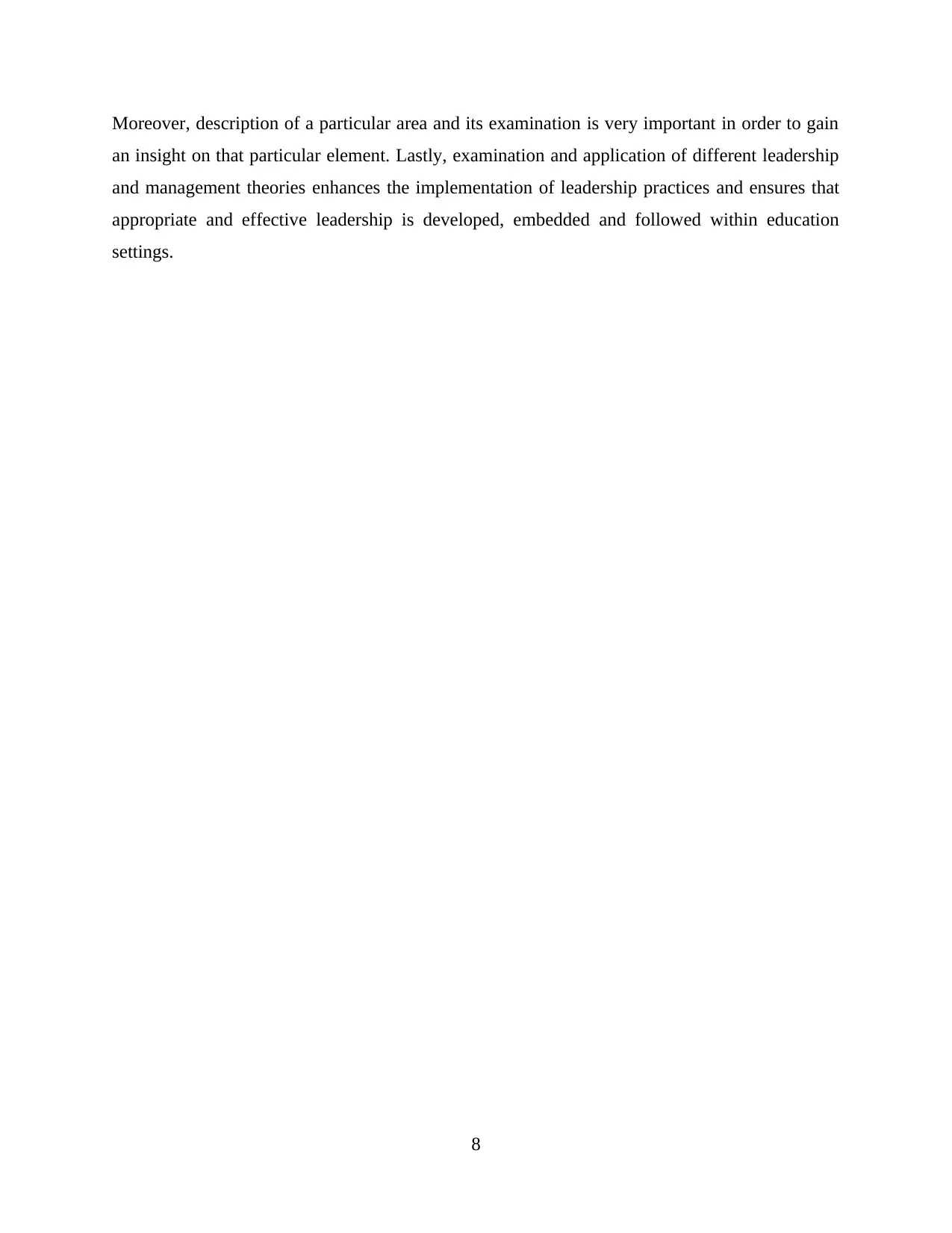
Moreover, description of a particular area and its examination is very important in order to gain
an insight on that particular element. Lastly, examination and application of different leadership
and management theories enhances the implementation of leadership practices and ensures that
appropriate and effective leadership is developed, embedded and followed within education
settings.
8
an insight on that particular element. Lastly, examination and application of different leadership
and management theories enhances the implementation of leadership practices and ensures that
appropriate and effective leadership is developed, embedded and followed within education
settings.
8
Paraphrase This Document
Need a fresh take? Get an instant paraphrase of this document with our AI Paraphraser
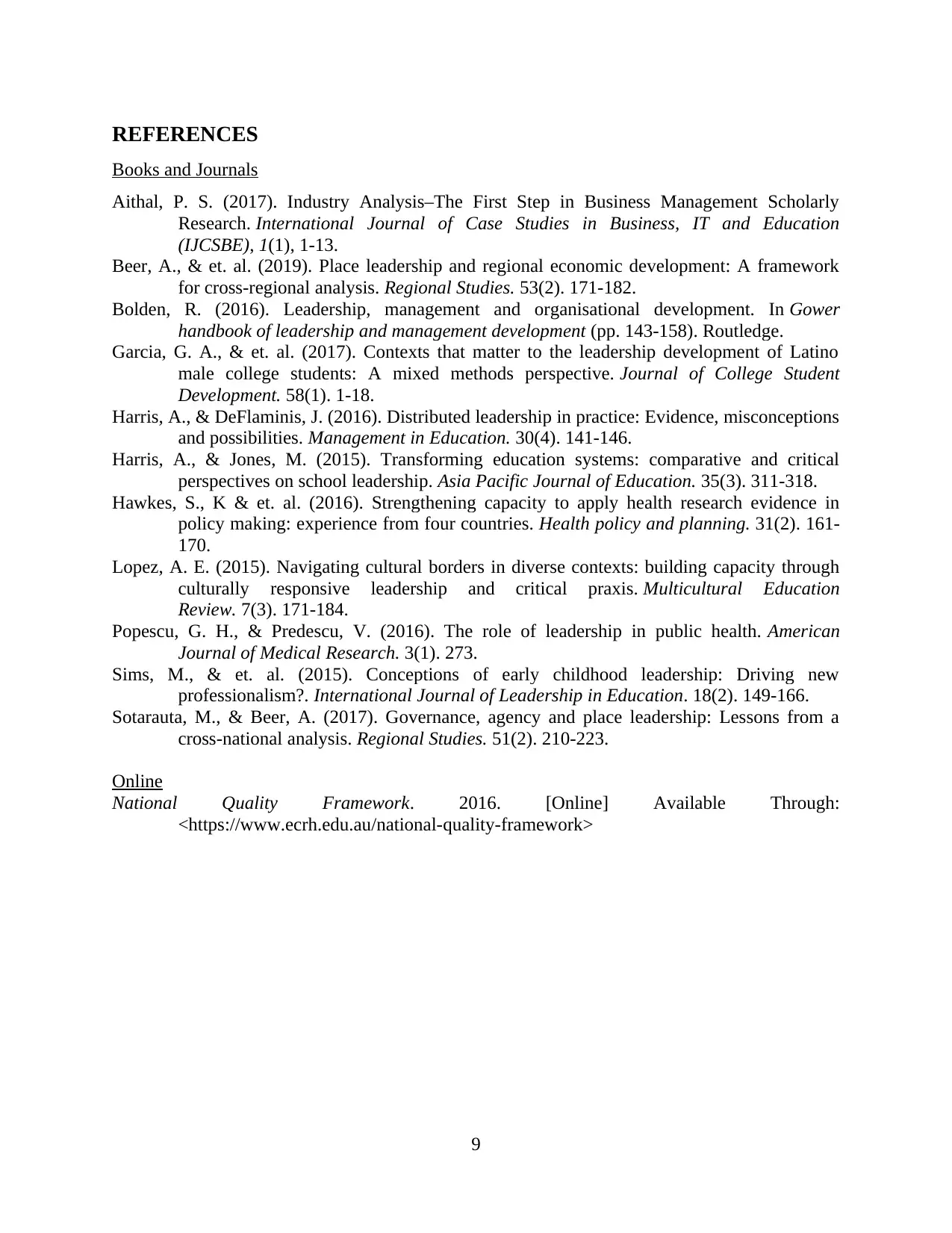
REFERENCES
Books and Journals
Aithal, P. S. (2017). Industry Analysis–The First Step in Business Management Scholarly
Research. International Journal of Case Studies in Business, IT and Education
(IJCSBE), 1(1), 1-13.
Beer, A., & et. al. (2019). Place leadership and regional economic development: A framework
for cross-regional analysis. Regional Studies. 53(2). 171-182.
Bolden, R. (2016). Leadership, management and organisational development. In Gower
handbook of leadership and management development (pp. 143-158). Routledge.
Garcia, G. A., & et. al. (2017). Contexts that matter to the leadership development of Latino
male college students: A mixed methods perspective. Journal of College Student
Development. 58(1). 1-18.
Harris, A., & DeFlaminis, J. (2016). Distributed leadership in practice: Evidence, misconceptions
and possibilities. Management in Education. 30(4). 141-146.
Harris, A., & Jones, M. (2015). Transforming education systems: comparative and critical
perspectives on school leadership. Asia Pacific Journal of Education. 35(3). 311-318.
Hawkes, S., K & et. al. (2016). Strengthening capacity to apply health research evidence in
policy making: experience from four countries. Health policy and planning. 31(2). 161-
170.
Lopez, A. E. (2015). Navigating cultural borders in diverse contexts: building capacity through
culturally responsive leadership and critical praxis. Multicultural Education
Review. 7(3). 171-184.
Popescu, G. H., & Predescu, V. (2016). The role of leadership in public health. American
Journal of Medical Research. 3(1). 273.
Sims, M., & et. al. (2015). Conceptions of early childhood leadership: Driving new
professionalism?. International Journal of Leadership in Education. 18(2). 149-166.
Sotarauta, M., & Beer, A. (2017). Governance, agency and place leadership: Lessons from a
cross-national analysis. Regional Studies. 51(2). 210-223.
Online
National Quality Framework. 2016. [Online] Available Through:
<https://www.ecrh.edu.au/national-quality-framework>
9
Books and Journals
Aithal, P. S. (2017). Industry Analysis–The First Step in Business Management Scholarly
Research. International Journal of Case Studies in Business, IT and Education
(IJCSBE), 1(1), 1-13.
Beer, A., & et. al. (2019). Place leadership and regional economic development: A framework
for cross-regional analysis. Regional Studies. 53(2). 171-182.
Bolden, R. (2016). Leadership, management and organisational development. In Gower
handbook of leadership and management development (pp. 143-158). Routledge.
Garcia, G. A., & et. al. (2017). Contexts that matter to the leadership development of Latino
male college students: A mixed methods perspective. Journal of College Student
Development. 58(1). 1-18.
Harris, A., & DeFlaminis, J. (2016). Distributed leadership in practice: Evidence, misconceptions
and possibilities. Management in Education. 30(4). 141-146.
Harris, A., & Jones, M. (2015). Transforming education systems: comparative and critical
perspectives on school leadership. Asia Pacific Journal of Education. 35(3). 311-318.
Hawkes, S., K & et. al. (2016). Strengthening capacity to apply health research evidence in
policy making: experience from four countries. Health policy and planning. 31(2). 161-
170.
Lopez, A. E. (2015). Navigating cultural borders in diverse contexts: building capacity through
culturally responsive leadership and critical praxis. Multicultural Education
Review. 7(3). 171-184.
Popescu, G. H., & Predescu, V. (2016). The role of leadership in public health. American
Journal of Medical Research. 3(1). 273.
Sims, M., & et. al. (2015). Conceptions of early childhood leadership: Driving new
professionalism?. International Journal of Leadership in Education. 18(2). 149-166.
Sotarauta, M., & Beer, A. (2017). Governance, agency and place leadership: Lessons from a
cross-national analysis. Regional Studies. 51(2). 210-223.
Online
National Quality Framework. 2016. [Online] Available Through:
<https://www.ecrh.edu.au/national-quality-framework>
9
1 out of 11
Related Documents
Your All-in-One AI-Powered Toolkit for Academic Success.
+13062052269
info@desklib.com
Available 24*7 on WhatsApp / Email
![[object Object]](/_next/static/media/star-bottom.7253800d.svg)
Unlock your academic potential
Copyright © 2020–2025 A2Z Services. All Rights Reserved. Developed and managed by ZUCOL.





